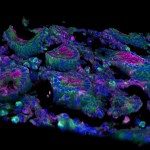Lien vers Pubmed [PMID] – 11461679
AIDS Res Hum Retroviruses 2001 Jul; 17(10): 937-52
We developed a simple, rapid, inexpensive, and highly sensitive and specific strategy for the detection and lineage differentiation of primate lentiviruses (PIV-ELISA). It is based on the use of two indirect ELISA methods using synthetic peptides mapping the gp41/36 region (detection component) and the V3 region (differentiation component) of four lentivirus lineages, namely SIVcpz/HIV-1 (groups M, O, N, and SIVcpz-gab), SIVmnd, SIVagm, and SIVsm/SIVmac/HIV-2. This strategy was evaluated with panels of sera originating from both humans and nonhuman primates. The human reference panel consisted of 144 HIV Western blot (WB)-positive sera in which the corresponding virus had been genotyped (HIV-1: 72 group M, 28 group O, and 6 group N; HIV-2: 21 subtype A and 10 subtype B; and 7 HIV-1+2) and 105 HIV WB-negative samples. The nonhuman primate reference panel consisted of 24 sera from monkeys infected by viruses belonging to the four lineages included in the PIV-ELISA strategy (5 chimpanzees, 5 macaques, 8 mandrills, and 6 vervets) and 42 samples from seronegative animals. Additional field evaluation panels consisted of 815 human sera from Gabon, Cameroon, and France and 537 samples from 25 nonhuman primate species. All the samples from the two reference panels were correctly detected and discriminated by PIV-ELISA. In the human field evaluation panel, the gp41/36 component correctly identified all the test samples, with 98% specificity. The V3 component discriminated 206 HIV-1 group M, 98 group O, 12 group M+O, and 128 HIV-2 sera. In the primate field evaluation panel, both gp41/36 and V3 detected and discriminated all the WB-positive samples originating from monkeys infected with SIVcpz, SIVagm-ver, SIVmnd-1, SIVmnd-2, SIVdrl, or SIVsun. These results were confirmed by genotyping in every case. Four SIV-infected red-capped mangabeys (confirmed by PCR) were correctly identified by gp41/36, but only two reacted with the V3 peptides in the absence of a specific SIVrcm V3 peptide. Addition of a V3 SIVrcm peptide discriminated all the SIVrcm-positive samples. Fourteen Papio papio samples were positive for SIVsm gp 36 and by WB, but negative by PCR, whereas three Papio cynocephalus samples were positive by gp41/36 but indeterminate by WB and negative by PCR. This combined ELISA system is thus highly sensitive and specific for antibodies directed against HIV and SIV. In addition, the V3-based serotyping results always agreed with genotyping results. This method should prove useful for studies of lentivirus prevalence and diversity in human and nonhuman primates, and may also have the potential to detect previously undescribed SIVs.

